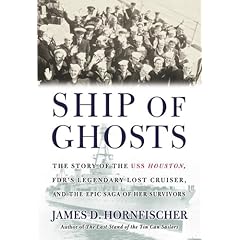Monday Maritime Matters
August 27th, 2007 by xformed
“You men are young, I have lived the major part of my life and I am willing to go.â€

The story of this series of events, and the fate of those of the USS HOUSTON’s crew who did survive is well told in Jmaes Hornfischer’s second book, “Ship of Ghosts:”

“Ship of Ghosts” tells the story of the history of the USS HOUSTON (CA-30)I found this poem at MaritimeQuest written for CDR Rentz:
COMMANDER GEORGE S. RENTZ – Chaplain, USS HOUSTON
A man of cloth, he chose to be,
among the men who followed the sea.
Dedicated to our crew – with infinite care,
he tended and wounded with earnest prayer.Unmindful of danger as the bombs rained down,
this man of god was always found.
Beside the dying and those terrible nights,
bringing strength and courage – and final rites.Thrown into the sea on the fateful night,
he watched our battered Houston sink from sight.
Seeking a raft in the light of a flare,
he knows that god had answered his prayer.A sailor at his side clinging to the raft,
was wounded’ and strength was ebbing fast.
Having no life belt to keep afloat,
his chance of survival was indeed remote.Without a thought for self, but he careful haste,
the chaplain fitted his life belt to the sailors waist.
The hours passed, and come dawn,
the sailor was safe, but the chaplain was gone.He had followed the law of the apostles Creed,
his life the price of a noble dead.
He went to his lord with no regret,
our fighting chaplain we’ll never forget.May his soul rest in peace – forever and ever, amen.
With reverence and affection,
Lloyd V. Willey
11-21-78
One ship has been named to honor the heroism of CDR Rentz, the USS RENTZ (FFG-43).

On November 5, 1986, Rentz was part of an historic visit to Qingdao (Tsing Tao; é’å²›) China—the first US Naval visit to China since 1949. Rentz was accompanied by two other ships, the Reeves (DLG-24) and Oldendorf (DD-972). The visit was officially hosted by the Chinese People’s Liberation Army Navy (PLAN). (“After 37-year absence, U.S. vessels visit China,” New York Times Nov. 6, 1986, Sec. A, p. 3)
If you like this type of history, make sure to backpedal a day and catch the Blogging Sea Lawyer, Eagle1, with his “Sunday Ship History” series. This week he talks about BRINGING THE HEAT, BABY!”
Category: History, Leadership, Maritime Matters, Military, Military History, Navy | Comments Off on Monday Maritime Matters






